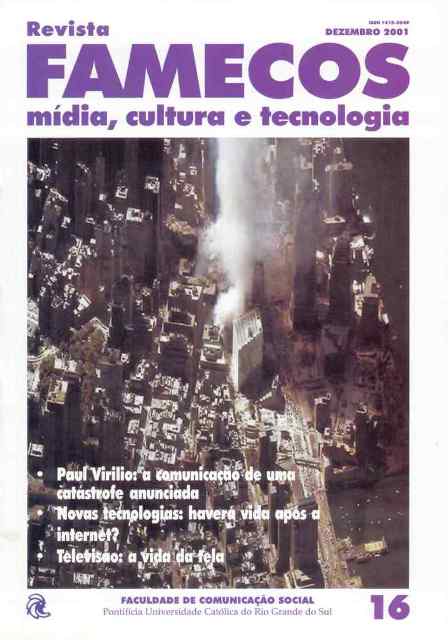Advertising as pedagogical support: the issue of discrimination in advertising of the Sukita
DOI:
https://doi.org/10.15448/1980-3729.2001.16.3143Keywords:
Communication, advertising, discriminationAbstract
The research that we carried out during the first semester of 2001 had as object the perceptions of advertising message (Sukita refrigerant) by second year high school students, during exhibition and debate in the classroom. The purpose of this study was to verify the relevance of using advertising as a pedagogical tool for discussing a transversal theme (age discrimination). The analysis of the recorded data points to a tendency on the part of the students of spontaneous uncritical manifestation in relation to the "socially authorized" model of the erotic-affective approach indirectly proposed by the advertising message.Downloads
References
ACCARDO, A. Introduction à une sociologie critique. Bordeaux: Le Mascaret, 1997.
ALTHEIDE, D. L. Qualitative media analysis. Thousand Oaks: Sage, 1996.
APPADURAI, A. The social life of things. Cambridge: Cambridge University Press, 1986.
BABBIE, E. Survey research methods. Belmont: Wadsworth, 1990.
BELENKY, M. F., CLINCHI, B. M., GOLDEBERGER, N. R. and TARULE, J. M. Womenʼ s ways of knowing: the development of self, voice and mind. New York: Basic Books, 1986.
BOURDIEU, P. La domination masculine. Paris: Seuil, 1998.
______. Le sens pratique. Paris: Minuit, 1980.
______. Méditations pascaliennes. Paris: Seuil, 1997.
CAMARGO, Nelly de. O léxico da publicidade”. Revista da Intercom, XVIII, n. 1, 1995.
CHENITS W.C.; SWANSON, J. Qualitative research using grounded theory. From practice to grounded theory. Menlo Park: AddisonWesley, 1986.
COSTA LIMA, L. Teorias da comunicação de massa. São Paulo: Paz e Terra, 1990.
DUBY, G. Lʼ Europe au Moyen-âge. Paris: Flammarion, 1984.
FERRER, J. A televisão e a escola. Porto Alegre: Artes médicas, 1996.
FOULIN, J-N., MOUCHON, S. Psychologie de lʼéducation. Paris: Nathan, 1998.
GODOY, Arilda S. Godoy. Introdução à pesquisa qualitativa e suas possibilidades. Revista de Administração de Empresas – FGV, São Paulo, v. 35, n. 2, 1995.
GRIGNOL, C. Lʼordre des choses. Paris: Minuit, 1971.
HELLER, A . O cotidiano e a história. São Paulo: Paz e Terra, 1970.
HOHLFELDT, Antonio. Hipóteses contemporâneas de pesquisa em comunicação: Teorias da comunicação. Petrópolis: Vozes, 2001.
KISH, L. Survey Sampling. New York: John Wiley & Sons, 1965.
KLINEBERG, O. Psychologie sociale. Paris: PUF, 1963.
LEISS, W., JHALLY, S. London: Routledge, 1997.
LIPPMANN, W. Public Opinion. Nova York: Free Press Paperbacks, 1997.
M. J. et P. H. Chombart de Lauwe et al. La femme dans la société. Paris: CNRS, 1963
NOËLLE-NEUMANN, E. “The spiral of silence: a theory of public opinion”, in Journal of Communication, v. 24. 1974.
QUEIROZ, M. I. P. Variações sobre a técnica de gravador no registro de informação viva. São Paulo: T.A . Queiroz, 1991.
RAJ, D. The design of sample surveys. New York: McGraw, 1972.
SCHAFF, A . Linguagem e conhecimento. Coimbra: Almedina, 1974.
SKINNER, Q. Fundações do pensamento político moderno. São Paulo: Companhia das Letras, 2000.
TESH, Renata . Qualitative research: analysis types and sotftware tools. New York: The Falmer Press, 1990.
VERRET, M. Le temps des études. Paris: H. Campion, 1975.
VINCENT, G. Lʼécole primaire francaise. Lyon: PUL, 1980.
VITORINO SAMPAIO, I. S. Televisão, publicidade e infância. São Paulo: Annablume, 2000.
Downloads
Published
How to Cite
Issue
Section
License
Copyright
The submission of originals to Revista Famecos implies the transfer by the authors of the right for publication. Authors retain copyright and grant the journal right of first publication. If the authors wish to include the same data into another publication, they must cite Revista Famecos as the site of original publication.
Creative Commons License
Except where otherwise specified, material published in this journal is licensed under a Creative Commons Attribution 4.0 International license, which allows unrestricted use, distribution and reproduction in any medium, provided the original publication is correctly cited.






